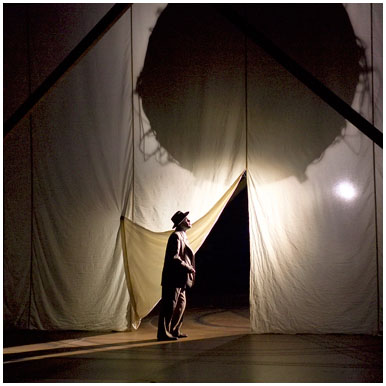Dr. Atomic blasts off

Batter my heart, three person'd God
To see a compelling new opera put on stage after years of talk, talk, talk and more talk is a thrilling experience, really. And so it was: John Adams' Dr. Atomic received its proper honors at a world premiere at the War Memorial Opera House in San Francisco Saturday night.
It joins Nixon in China and Death of Klinghoffer in rounding off the Adams-Sellars team's own trinity of epic operas inspired by recent history. Judging from initial exposure (I'll be seeing it again next week), this may well be the creators' most intense and absorbing work to date, a tale communicated by means of a mature stylistic language that has been refined by many decades of close collaboration. And for a pair known for their cutting edge and often alienating avant-garde excursions, this piece is remarkably accessible.
SFO scene shop: The Bomb -- photo by Will Hamilton
As expected, Dr. Atomic wasn't free of birth pangs, and perhaps the most dramatic of these was when Alice Goodman unexpectedly withdrew as the librettist from the project -- very late in the project's timeline, at a time when Adams had expected delivery on the complete libretto. So bless Peter Sellars once again for his intelligence and talent, saving the project by stitching together a patchwork of letters, memoirs and poetry into a compelling and surprisingly episodic narrative. 
Pam, John and Pete -- photo by Chris Lee
Once it became clear that Goodman would not be supplying the libretto to this opera, Pamela Rosenberg's concern with Sellars' schema was that it risked turning Dr. Atomic into an oratorio, or a string of set pieces with limited dialogue or interaction. Rosenberg's concerns were unfounded, as it turns out that Dr. Atomic is a remarkably accessible theater piece, even to those who find might find Sellars' stage works to be hopelessly non-linear.
Musically, Adams' writing is a virtuosic blend of lyricism and contemporary compositional techniques, ripened well beyond the wacky experimental settings most of us have become accustomed to associate with this style of music. He sets off Varesian electro-acoustical landscapes, deployed not as mere abstract environments, but as skillfully contextualized sonic vistas depicting the vast expanse of the desert, broken by the sharp-edged intrusion of the frenzy of activity at the Trinity test site. The glowing, pulsating minimalist ostinatos which characterizes so much of Adams music, capture not only the relentless claustrophobic energy of the test site, but also the psychology of cyclical moral conundrums. 
Gerald Finley (Robert Oppenheimer)
Above all, there is vocal writing of extraordinary intensity and majesty. In a performance keenly aware of the magnitude of the event, Gerald Finley gave a visceral, role-defining portrayal of Oppenheimer. Of course, the character's superb chaccone set to John Donne's "Batter my heart, three person'd God," which closes Act I, is soon to become a choicest assignment among leading dramatic baritones. Few future interpreters, however, are likely to capture the meticulously choreographed staging by Peter Sellars of this aria, which finds Oppenheimer writhing his body, externalizing the moral predicament of the character in tragic contortions.
Contributions by the rest of the cast aptly matched the stature of the occasion. True, the role of Kitty Oppenheimer had Lorraine Hunt-Lieberson written all over it (Hunt-Lieberson withdrew from the production due to chronic illness), but Kristine Jepson [the charismatic mezzo who in 2000 alternated with Susan Graham as Sister Helen Prejean in Jake Heggie's Dead Man Walking] rose beautifully to the assignment, and more than a mere trouper, offered a truthfully felt reading of the poignant act 2 soliloquy. 
Oppie and Kitty (Gerald Finley and Kristine Jepson)
Oppie, Teller and Pasqualita (Finley, Richard Paul Fink, and Beth Clayton)
The tightly rehearsed ensemble cast -- Eric Owens (General Groves); Richard Paul Fink (Edward Teller); James Maddalena (Hubbard); Jay Hunter Morris (Nolan) and Beth Clayton (Pasqualita) -- all gave strong performances, rising to the challenge of Sellars' notoriously exacting demands. Surprisingly strong also was the young Canadian tenor Thomas Glenn, who stepped into the production very late, replacing tenor Tom Randle in creating the role of the idealistic young physicist Robert Wilson.
Thomas Glenn (as Robert Wilson)
Aside from key defining moments, Sellars kept his trademark resource of gestural externalization to quite modest levels in this staging -- leaving much of this externalization to the dancers, and Lucinda Childs' cleanly executed choreography -- but still, there was his unmistakable signature in the tableaux and scenes presented.
True, the work could use some tightening on the second act, but after all these years, Sellars' stage imagery still mesmerizes, surprises, and absorbs you into his world -- making opera just as fresh and exciting as his Mozart/Da Ponte trilogy was back in the late 80's. And with upcoming stagings of Dr. Atomic at Amsterdam's De Nederlandse Opera; the Lyric Opera of Chicago; and Torino, Italy; before its MET debut, there is little doubt that Dr. Atomic will quickly establish itself as a major contribution to the repertoire. 
The blast -- SF Opera Chorus
[Except where indicated, all photos on this entry by Terrence McCarthy, used with permission from the SF Opera.]
© 2005 C. Chang
Want to be notified of new Bay Buzz articles? Send an e-mail message with the subject "PLEASE NOTIFY ME" to this address. (Names and addresses kept strictly confidential.)
Back to home





0 Comments:
Post a Comment
<< Home